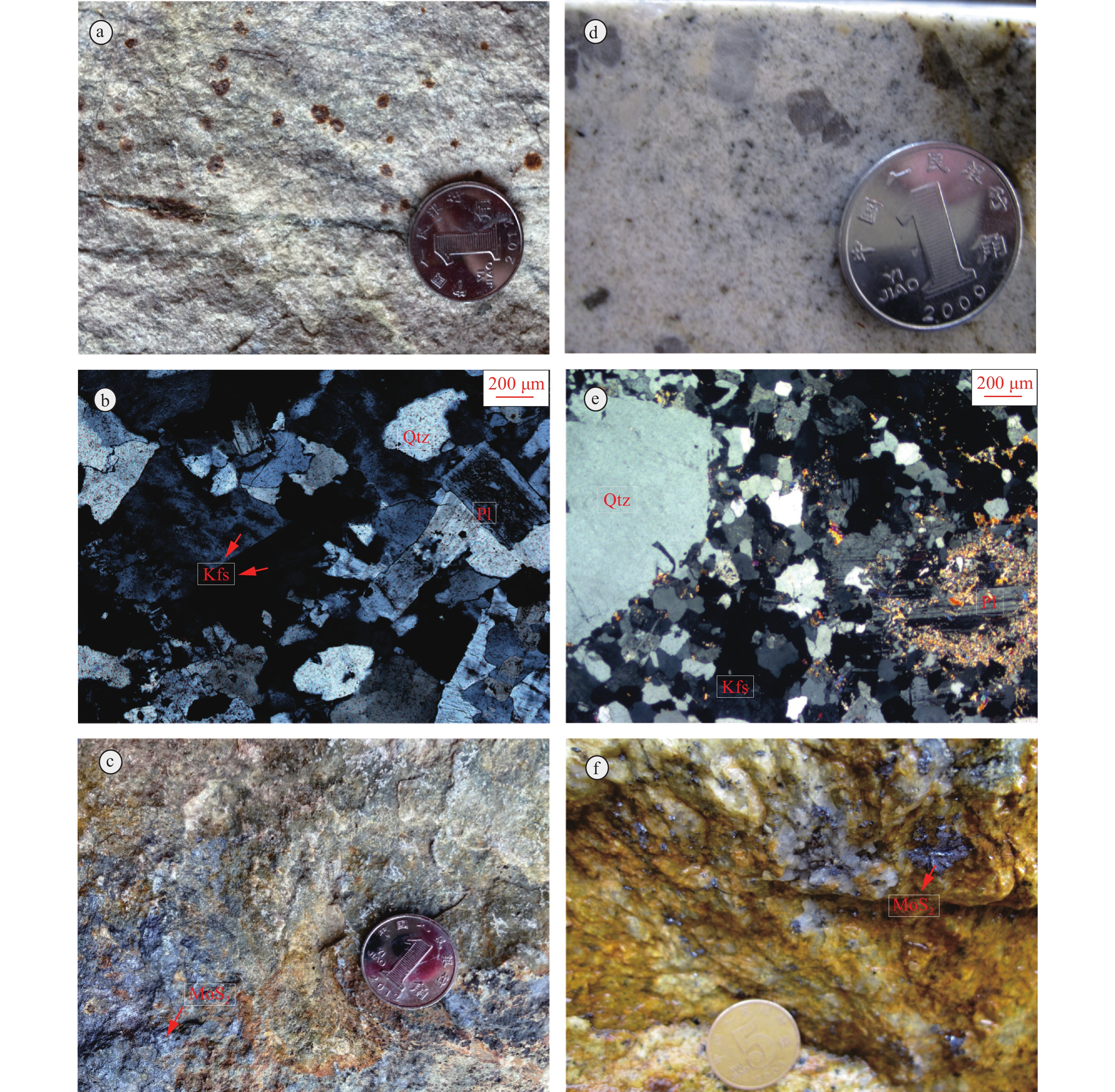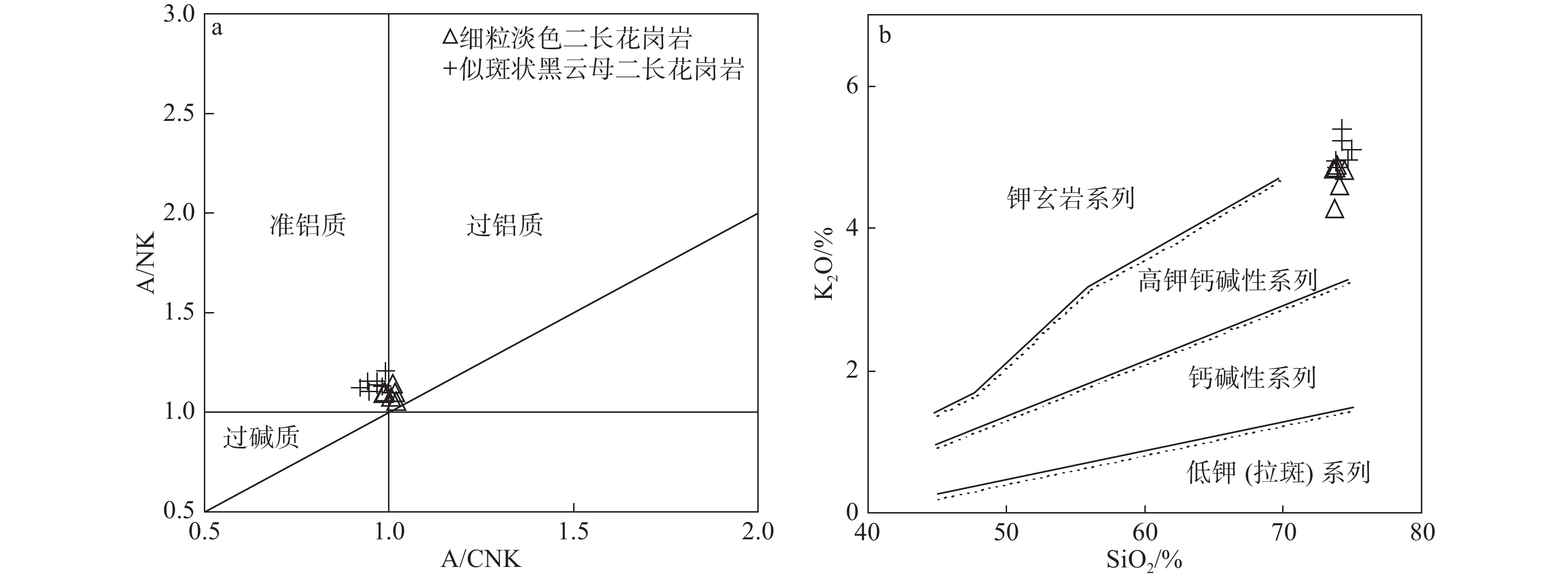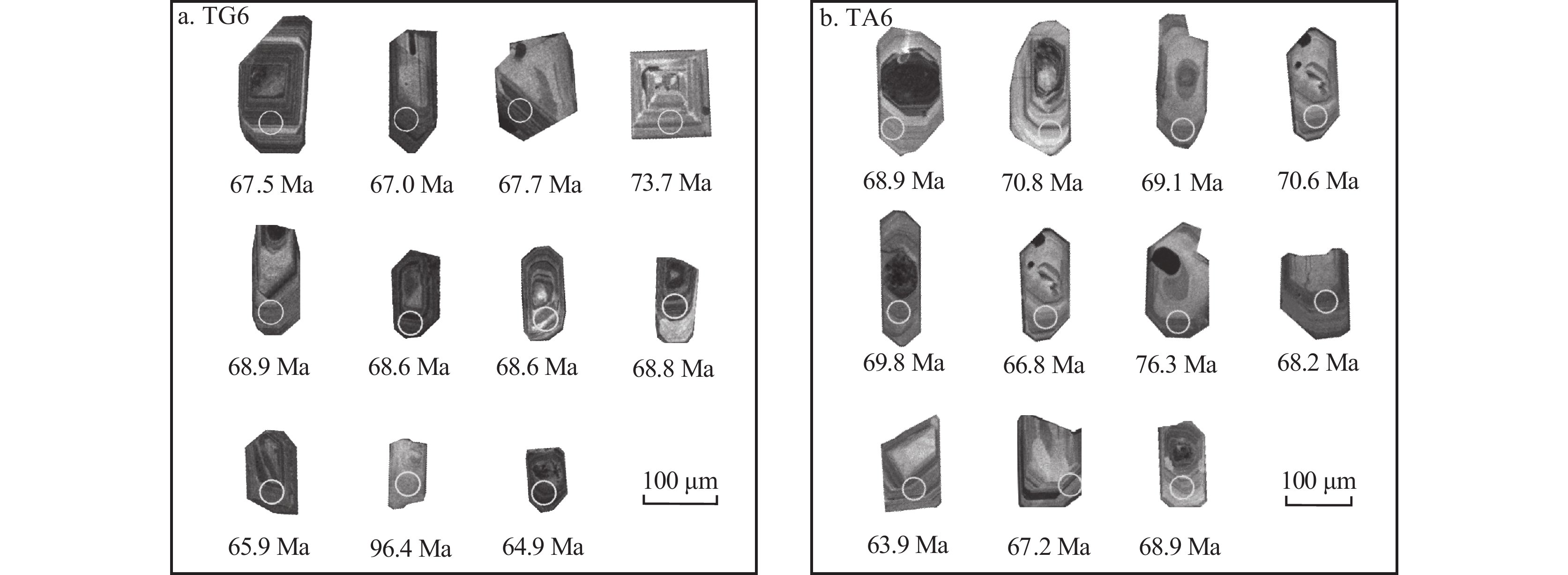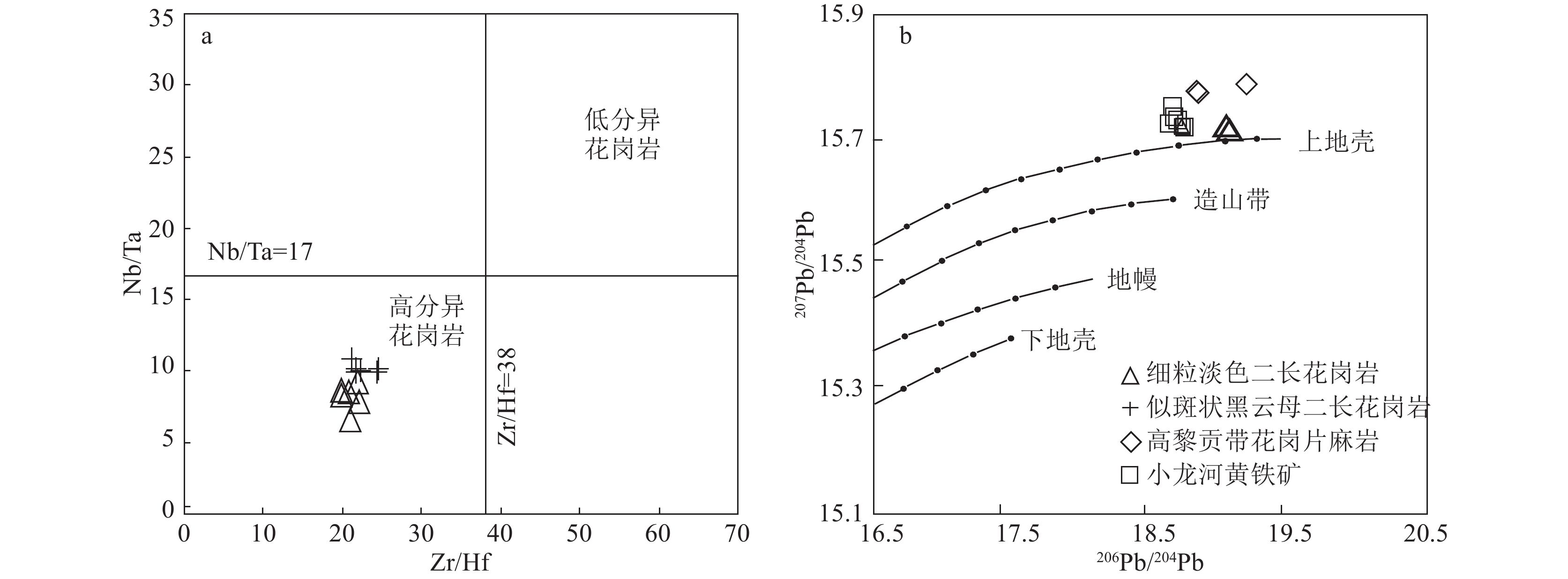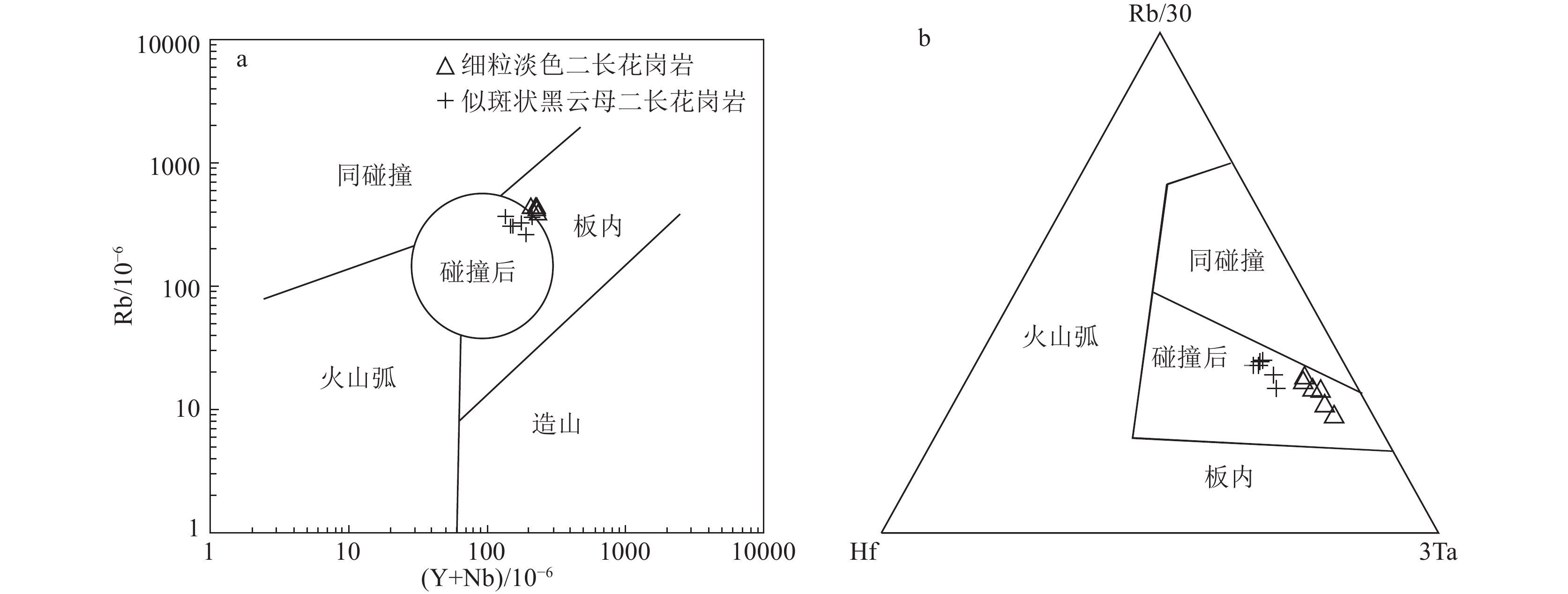Geochronology and mineralization significance of the Late Cretaceous Xiaolonghe granite in the Tengchong Block
-
摘要:
为厘定腾冲地块晚白垩世构造岩浆活动和花岗岩成矿意义,对小龙河花岗岩开展全岩地球化学、年龄和锶−钕−铅同位素研究。小龙河花岗岩由细粒淡色二长花岗岩和似斑状黑云母二长花岗岩组成,锆石U−Pb年龄数据指示它们的岩浆结晶年龄分别为67.0±1.0 Ma和68.5±1.6 Ma,辉钼矿Re−Os模式年龄分别为67.15±0.99 Ma和69.02±1.22 Ma,同为晚白垩世构造岩浆活动产物。锶−钕−铅同位素与主量和微量元素特征表明,细粒淡色二长花岗岩为S型花岗岩((87Sr/86Sr)i=0.757 ~ 0.763); εNd(t)=−8.89 ~ −8.99)),岩浆起源于中元古代(TDM2=1.59 ~ 1.60 Ga)上地壳富粘土硬砂岩部分熔融,其与小龙河锡−钨多金属矿床形成密切相关;似斑状黑云母二长花岗岩为I型花岗岩((87Sr/86Sr)i=0.711, εNd(t)=−8.72 ~ −9.16),岩浆起源于中元古代(TDM2=1.58 ~ 1.62 Ga)下地壳富粘土硬砂岩重熔。腾冲地块晚白垩世小龙河花岗岩及其锡−钨矿化是中特提斯班公-怒江洋闭合后腾冲地块与保山地块碰撞−后碰撞阶段引发的岩浆活动与热液作用的产物。
-
关键词:
- 腾冲地块 /
- 晚白垩世 /
- 锆石SHRIMP U−Pb定年 /
- 辉钼矿Re−Os定年 /
- 锶−钕−铅同位素地球化学
Abstract:In order to determine the Late Cretaceous tectonomagmatic activities and the significance of granite mineralization in the Tengchong Block, this study applied the comprehensive methods of geochronology, Sr−Nd−Pb isotopic and whole−rock geochemical analyses to probe Xiaolonghe granites. The results show that the Xiaolonghe pluton is composed of fine−grained leuco−monzogranite and porphyritic−like biotite monzogranite. Zircon U−Pb chronological data indicate that their magmatic crystallization ages are 67.0±1.0 Ma and 68.5±1.6 Ma respectively, and the Re−Os model ages of molybdenite are 67.15±0.99 Ma and 69.02±1.22 Ma respectively, both of which are the products of the Late Cretaceous tectonomagmatic activities. The characteristics of Sr−Nd−Pb isotopes and major and trace elements show that the fine−grained leuco−monzogranite is S−type granite ((87Sr/86Sr)i=0.757 ~ 0.763, εNd(t)=−8.89 ~ −8.99), and the magma originated from the partial melting of clay−rich hard sandstone in the upper crust of Mesoproterozoic(TDM2=1.59 ~ 1.60 Ga), which is closely−related to the formation of Xiaolonghe tin−tungsten polymetallic deposit. The porphyritic−like biotite monzogranite is I−type granite ((87Sr/86Sr)i=0.711, εNd(t)=−8.72 ~ −9.16), and the magma originated from the remelting of clay−rich hard sandstone in the lower crust of Mesoproterozoic(TDM2=1.58 ~ 1.62 Ga). The Late Cretaceous Xiaolonghe granites and its tin−tungsten mineralization in the Tengchong Block are the products of magmatic activity and hydrothermal process caused by the collision or post−collision between the Tengchong Block and the Baoshan Block after the closure of the Meso−Tethys Bangong−Nujiang ocean.
-
地下水污染可对饮用水安全、人体健康和社会可持续发展产生严重影响。2021年12月1日,国务院颁布实施《地下水管理条例》(中华人民共和国国务院令第748号),表明国家对于地下水污染防治工作高度重视。防控地下水污染,开展源头保护是重中之重。地下水污染具有隐蔽性,因此开展地下水污染溯源和解析显得尤为重要。为了有效识别和解析地下水污染,需要采用科学的方法和技术,结合现场调查和实验分析,确定污染物的来源、性质、分布等信息。传统方法,如水化学离子分析法、同位素法、主成分分析法等已经被广泛应用(闫颖等,2020;Huang et al.,2021;马春龙等,2021),但也存在一定的局限性。近年来,随着科技的进步和新型方法的发展,如模拟优化法、正定矩阵因子分析模型,以及决策树、随机森林、自组织映射技术等人工智能领域的方法,为地下水污染源解析提供了新的思路和手段(林斯杰等,2020;Constantinos et al.,2022;Hamed et al.,2022;许明明等,2022)。
本文重点介绍目前较成熟的同位素法、荧光光谱法、主成分分析法、地质统计学法,以及新发展的正定矩阵因子分析模型和自组织映射技术在地下水污染源解析中的应用,阐述这些方法在地下水污染源解析中的原理、适用性、优缺点等,探讨不同方法间的联合应用和发展前景,为地下水污染源解析工作提供参考。
1. 源解析方法综述
1.1 同位素法
同位素是具有相同原子序数的同一化学元素的2种或多种原子之一,不同环境水体由于成因不同而具有不同特征的同位素组成。通过分析不同环境中水体同位素的“痕迹”,可以判断其形成和转移,进而判断地下水污染程度、污染物来源等(杨琰等,2004;张应华等,2006;李先国等,2009;庞凤梅等,2011;闫颖等,2020;赵然等,2020)。在地下水污染源解析研究中,硝酸盐、硫酸盐、金属等同位素方法多年来已被国内外学者多次应用。
硝酸盐同位素是一类很常用的同位素法。硝酸盐是地下水中常见的污染物,而不同来源的硝酸盐在化学形式上很难区分。氮氧同位素技术是识别具有不同同位素组成的硝酸盐污染的直接手段(杨琰等,2004),它可以根据不同来源的同位素特征值进行地下水污染源解析。Torres et al.(2020)使用同位素示踪剂结合贝叶斯同位素混合模型,对墨西哥蒙特雷河谷的地下水硝酸盐和硫酸盐污染进行跟踪,判断其污染的不同来源和转化过程,研究结果表明,蒙特雷河谷地下水中硝酸盐和硫酸盐的污染来源主要为城市污水渗漏。Huang et al.(2021)利用多元同位素(δ15N-NO3、δ34S-SO4、δ18O-SO4、δ13C-DIC)研究了Piedmont地区的山前冲积扇地下水硝酸盐污染,得出粪便/污水是补给区非承压和承压地下水中硝酸盐的主要来源,证明了使用多种同位素技术阐明硝酸盐来源及其在地下环境中迁移途径的可行性。根据国内外研究总结的硝酸盐氮氧同位素值域见表1(吴娜娜等,2017)。由于氮氧双同位素法无法考虑空间变异、反硝化过程中的同位素分馏和混合物可能存在的多个来源等问题,近年来通常使用贝叶斯同位素混合模型(Stable Isotope Analysis in R,简称SIAR)。将多元同位素与SIAR模型相结合,可以消除硝化、反硝化或挥发过程中可能存在的不确定性,从而定量分析硝酸盐的污染来源及其转化过程(Torres et al.,2021)。
表 1 不同污染源硝酸盐氮氧同位素值域范围(据吴娜娜等,2017)Table 1. The range of nitrogen and oxygen isotope ratios of nitrate from various pollution sources污染源 δ15N 典型值域范围/‰ 均值/‰ 大气NO3−沉降 −7.7 ~ +5.8 −0.4 大气NH4+沉降 −11.1 ~ +2.3 −4.3 粪肥 +5.9 ~ +22.0 +12.7 污水 +4.6 ~ +18.4 +11.4 土壤氮 −3.5 ~ +9.0 +2.2 NO3−化肥 −2.7 ~ +2.3 0 NH4+化肥 −2.0 ~ +4.0 +0.3 污染源 δ18O 典型值域范围/‰ 均值/‰ 大气沉降作用 +25.0 ~ +75.0 +54.2 硝态氮肥 +18.0 ~ +25.7 +21.7 土壤微生物硝化作用 +3.5 ~ +16.8 +10.6 硫酸盐同位素由于指示能力较好,经常与氮氧同位素一起应用,图1为地下水中不同来源的δ34S-SO4 和 δ15N-NO3典型值,两者结合应用可以对受硝酸盐和硫酸盐混杂污染的场地起到更好的指示作用。Li et al.(2006)研究四川盆地地下水、雨水和煤中硫酸盐的δ34S,得到了地下水硫酸盐的主要来源为雨水、人类农业活动等。铬、铅、硼等稳定同位素也在工业生产、矿山污染等重金属相关的地下水污染源解析中存在一定应用(Cheng et al.,2010;郝红等,2013;Nisi et al.,2016;Kanagaraj et al.,2018)。此外,Voltaggio et al.(2015)使用氢、氧、锶、铀、镭等放射性同位素调查污染井中高盐度的来源,并考虑了镭同位素在地下水研究中的2种作用,包括作为示踪剂分析水岩相互作用及用228Ra与226Ra的比率评估地下水在浅水区的停留时间。
有机单体同位素分析(Compound-specific Isotope Analysis,简称CSIA),是分子有机地球化学和同位素地球化学互相渗透交叉的产物,可诊断有机污染来源(Schmidt et al.,2004;刘国卿等,2004)。CSIA技术可以连续测定气相色谱流出的每一个生物标志化合物碳、氢稳定同位素的组成,可成为污染物来源判识与过程示踪的有力工具。随着科技的发展,该技术可以进行氮、氧、氯、氢等单体稳定同位素的检测,也可被广泛应用于多环芳烃、氯代烃、农药残留物、农用化学品等有机污染物的检测研究中。此外,它已经在一些典型的污染场地中成功识别出有机污染物的来源(Glaser,2005;张琳等,2009;王晓红等,2013;左海英,2015)。
综上所述,同位素法由于涵盖元素广、分析结果精确、可参考经验数值多等原因,在地下水污染源解析中有着十分广泛的应用。在农业化肥污染、生活污水、工业污染等人为源污染造成的地下水污染中,硝酸盐同位素法和硫酸盐同位素法都是比较常用且精确的定量解析方法,但实际应用时存在同位素比值重叠的问题(王会霞等,2021),而且相比于一些多元统计学方法,需要耗费更多的成本和时间,为了解决这一问题,在硝酸盐转化过程中几乎不发生同位素分馏的硼同位素可以与硝酸盐、硫酸盐同位素联合使用(Frank et al.,2012)。铅和铬同位素在实际环境中通常受外界影响变化较小,因此在环境同位素示踪中得到广泛应用,但目前应用在地下水源解析的案例较少。CSIA技术可以对有机物进行地下水污染溯源,但是存在检出限较低的局限,使用 GC-C-IRMS 测量时要求提供的化合物中至少含有1 nmol的碳和8 nmol的氢才能满足气相分离要求的分辨率并得到较好的峰形,因此低浓度的有机污染限制其在地下水污染溯源中的应用;同时由于并未确定有机单体同位素的标准物质,也导致了该技术在地下水有机污染源解析方面不够成熟(张琳等,2009)。为了使CSIA技术在地下水源解析中的应用性更高,需要深入了解不同环境中有机物同位素的分馏效应,尝试CSIA应用于C、H、N、O等元素以外的更多种类元素上的可行性,并且进一步对CSIA所用仪器的灵敏度、浓缩效率等制约条件进行改进。
1.2 荧光光谱法
荧光光谱法是利用光谱学原理分析物质结构特征和化学成分的方法,经常被用于海洋、河流、地下水等水体污染检测(Chen et al.,2003;Zhang et al.,2021)。常用的光谱法有三维荧光光谱法、同步荧光光谱法、时间荧光光谱法等。其中,三维荧光光谱法的原理是物质所含荧光基团被激发波长照射时产生发射波,通过获得激发波长和发射波长同时变化时的荧光强度信息,将不同激发波长和发射波长下的荧光强度以三维投影图的形式展示,可直观准确地描述不同荧光物质的组成。由于不同水体的荧光光谱在荧光峰位置、强度、个数等方面存在差异,因此研究不同水体的荧光指纹特征可以达到污染溯源的目的(陈宇男,2017;智国铮,2021)。
已有研究表明,不同污染来源的水体中含有的荧光类溶解性有机物存在差异,包括印染、造纸、炼油、生活污水等污染源(智国铮,2021)。图2展示了水体中各种DOM荧光区域划分(Chen et al.,2003),不同类型的荧光物质可以作为地下水污染的来源依据。周圆等(2020)发现,印染类型水体中主要存在酪氨酸类和色氨酸类的蛋白质荧光峰;Zhang et al.(2021)利用DOM荧光的特性,使用荧光光谱法结合多元统计学,发现畜牧业污染可以提高地下水的DOC含量、微生物来源的DOM、芳香度、荧光强度和类色氨酸成分的比例,但会降低类腐殖酸成分的比例和DOM的分子量。因此,类色氨酸荧光可以作为畜牧业污染地下水的示踪剂。赵丽等(2020)采用三维荧光光谱及紫外可见光谱技术,对豫北某城市生活垃圾填埋场内监测井的水样进行了“三氮”、溶解性有机质等含量特征的测定及源解析。何小松等(2014)的研究表明,结合光谱技术与多元统计分析可以识别受垃圾渗滤液污染的地下水点位。彭莉等(2018)结合现代光谱技术及多元统计分析方法,研究了常规水质检测手段难以识别的微污染填埋场地下水有机物组成、分布等特征。
三维荧光光谱法有灵敏度高、选择性好、测试迅速、消耗化学药剂少、仪器操作简单等优点,但仅能够识别人为来源有机质类污染组分的影响,在应用情景上存在局限性(智国铮,2021)。同时,由于三维荧光光谱特征受到pH值、温度、金属离子等因素的影响,使用单一少量的荧光图谱对污染特征进行解析也存在不确定性,因此需要完善污染源水质荧光指纹数据库。
1.3 地质统计学法
地质统计学是空间统计学的一个分支,可用来描述空间模式并提供未采样位置的属性值估计。通过地质统计学提供的综合框架可以组合不同类型的数据集以构建空间不确定性的局部模型(Constantinos et al.,2022),图3为应用地质统计学解决地下水盐渍化问题时的3个主题领域。克里格方法是一种常用的地质统计学技术,它基于无偏最优估计理论(侯景儒,1997),通过估计待求污染源排放历史的函数,得到反问题的解,进而追溯污染源。该方法也可以通过数值实验来分析观测点布设位置、污染物浓度观测误差、水动力弥散参数、地下水流速等影响溯源效果的因素。图3为地质统计学主要涉及的领域。
地质统计学法经常被用于地下水盐碱化的研究,在地下水污染源解析方面应用有限。通过地质统计空间插值方法可以构建水文地质或其他参数(TDS、硝酸盐等)的空间分布图,从而进行污染源解析的研究。张凯等(2020)以广西某乡镇潜层地下水为研究对象,将地质统计学法和多元统计分析法相结合,分析了污染因子的空间分布和来源,识别出该研究区地下水中硫酸盐和氟化物的污染来源为岩石中硫酸盐与含氟矿物的溶解及工业园区的排水下渗。龙玉桥等(2017)将地质统计学法应用于追溯一维均质含水层中污染源的排放过程,利用数值实验分析了污染物浓度观测误差、水动力弥散参数等条件对地质统计学的溯源效果影响。Nazzal et al.(2015)将地质统计学方法中的变差函数分析与主成分分析法结合,将污染源分为2个因子——水岩相互作用和人为影响,并判断影响地下水质量的因素在不同位置如何变化。
地质统计学法常与各类多元统计法相结合,以降低大型数据集的维度从而识别变量。地质统计学分析可以在稀疏测量点位的基础上,绘制不同指标的空间分布图及判断成分来源。为了提高该方法的准确性,避免插值可能出现的不确定性,国内外研究者们将重心更多地转向了模拟、优化扩展及引入更多机器学习方法等。
1.4 主成分分析法
主成分分析法(Principal Component Analysis,PCA)作为一种常用的基于降维思想的多元统计方法,通过充分利用全部数据所包含的信息,以主成分贡献率作为指标权重值,将多变量化简为少数变量,从而使数据的复杂度降低(周广峰等,2011)。由于PCA法只是一种定性聚类的方法,在地下水污染源解析研究中,通常会与其他方法联用,提高方法的准确性或定量解析。Chen et al.(2019)将PCA与修正灰色关联分析(MGRA)结合,对拉林河流域进行污染评估,分析出研究区在雨季和旱季分别存在5个和4个潜在污染源。同时,通过将PCA法与点位实际空间位置结合分析,更进一步得出流域北部地下水质量差的原因是研究区的高度城市化。Rashid et al.(2020)通过使用主成分分析-多元线性回归法(PCA-MLR),判断巴基斯坦北部某地区混合工矿区地下水包含自然源、人为污染、混合源等重要来源。近年来,主成分分析-绝对主成分得分-多元线性回归(PCA-APCS-MLR)作为PCA-MLR方法的改进,在地下水污染源解析研究中被广泛应用。 Li et al.(2018)使用PCA-APCS-MLR对典型河边地下水资源区的浅层地下水进行研究,分析了10 a的地下水质量变化,发现水-岩相互作用、农业肥料及生活和工业废水是地下水污染演变的原因。此外,PCA法还与模糊综合评价法(FCA)、地理信息系统(GIS)等多种方法结合使用。
PCA法通过各因子中所含组份解释不同污染源的贡献率,只需要污染水质数据便可操作,方法简单,由于其较高的适用性而在地下水污染源解析中广泛应用,经过改进后的PCA-APCS-MLR法也能起到较好的定量解析结果,它可以计算Eh、pH值等非浓度水质指标,但由于不同主成分之间的正交性约束,导致其在划分污染来源时结果可能更分散及杂乱。作为一种传统定性方法,该方法多与其他方法联用,在地下水源解析方面相对于同位素法往往不够精确,但也可以做到一定程度的替代,因此该方法在进一步的发展中,可以寻找更多能与其联用的传统方法或新型方法,同时也可以在原来的基础上做出改进。
1.5 正定矩阵因子分析模型
正定矩阵因子分析模型(Positive Matrix Factorization, PMF)是由Paatero等于1993年开发(Paatero et al.,1994),经美国环保署(USEPA)认可并改进的多变量因子源解析受体模型(Taghvaee et al.,2018)。PMF法基于环境受体样本的化学组分数据,不依赖于污染源的化学成分谱,利用最小二乘法进行迭代运算,求解出组分浓度和污染源间的化学质量平衡。PMF作为一种受体模型,可以对因子分解矩阵进行非负约束,并且考虑到数据存在的不确定性误差,从而使解析结果更具有实际意义。
PMF法经常被用于水体、沉积物、空气颗粒物等的污染源识别和贡献率计算,在地下水污染定量源解析方面有着一定的应用。孟瑞芳等(2021)利用PMF模型对滹沱河冲洪积扇地下水污染进行定量源解析,通过PMF计算结果并结合当地实际情况,得出污染源主要是生活污水和化肥、工业污染源和地下水超采诱发的水岩交互作用。郭涛等(2017)通过PMF识别结果表明农业源和自然源是影响拉林河流域地下水水质的主要来源,其中受总硬度、TDS、硫酸盐和氯化物4个指标影响的自然源贡献占比约61.5%,被自然因素影响的铁锰及农药化肥过量使用产生的氨氮、硝酸盐所影响的农业混合源占比约38.5%。Hamed et al.(2022)利用PMF方法分析得出中东乌尔米亚湖盆地东部的地下水污染主要有5个来源:第一个来源为钠氯贡献最高的高盐度湖水渗入;第二个来源中钙、镁、重碳酸根等指标贡献最高,为可溶性盐类的浸出,这种浸出源于母岩风化和乌尔米亚湖流域的基肥;第三个来源中氟、铅、铬贡献最高,这是工业与城市污水的结合;第四个来源中铜、镍贡献最高,为研究区固体废物的渗滤液释放;第五个来源中锌、钾贡献率最高,被判断为居民区的车辆燃料等情况造成的污染。PMF判断源的结果为湖水/溶解矿物质/化肥(46%)>固体废弃物渗滤液(29%)>工业-市政废水(18%)>机动车排放量(7%),显示出比PCA-MLR更高的相关性,能够更好地区分湖水入渗、矿物溶解等自然源中的成分。
PMF法通过使用标准偏差进行数据优化,与PCA-APCA-MLR方法相比,PMF通常具备更高的决定系数R2,计算得出的污染源贡献率更准确。PMF作为近年来才逐步应用于地下水污染源解析的方法,在优缺点和适用性上的研究还不够深入。其中,在PMF计算时可以在其自带的BS-DISP误差估计上进一步研究,BS-DISP误差将BS(Bootstrap)随机误差估计和DISP(Displacement)的因子分解不确定性估计的优势结合,它能在DISP和BS诊断效果较好时发生因子交换,从而辨别因子的更多不确定性来源。
1.6 自组织映射技术
自组织映射技术(Self-organizing Map,SOM)是通过神经元间的竞争学习将相似的数据映射到相邻位置并保持拓扑结构不变的一种方法(林斯杰等,2020)。1973年von der Malsburg在树皮细胞研究中最初提出并使用了SOM技术(Malsburg,1973),Kohonen于1981 年将该技术完善,将SOM模型发展成更简洁、应用更广泛的机器学习方法(Kohonen,1982,1996)。SOM有很强的聚类能力,在模拟大脑神经系统的生物学基础上,可以对输入的多维样本数据进行自动排序和自动分类,从而将输入的样本以数据特性为特征进行无监督竞争式训练,最后将多维数据降维并聚类。SOM操作建立在MATLAB或Python等软件的编程上,所受的局限性较少。该技术允许数据缺失,无需删除或插值并构建输入和输出之间的关联模式,擅长处理复杂、离散的数据(马春龙等,2021)。
在地下水污染源解析应用上,SOM技术可以将污染物的种类和浓度与污染场地监测点位有效聚类,在K均值、模糊C均值等方法的补充下,将聚类结果合理分区,由此进一步判断监测点位间的同源性及污染物间的相关性。如图4所示,SOM法能够将不同污染指标聚类,快速挖掘复杂多维的污染场地监测数据,有效完成关键信息的提取,有助于污染源的追溯。Torres et al.(2020)将SOM法和多元同位素与贝叶斯同位素混合模型相结合,确定了墨西哥南下加利福尼亚地下水含水层硝酸盐、硫酸盐的来源。林斯杰等(2020)将SOM法与PCA法结合对北京市平谷区进行地下水溯源,通过SOM法识别了污染物的空间分布,进一步补充解释了PCA方法中非公因子的污染指标关联性和来源。Lee(2019)将SOM技术和模糊C均值结合对韩国首尔某地区地下水污染情况进行聚类分析,得出破损的下水管道污水、地铁隧道、城市中心等地是该地区地下水污染主要来源。Mao et al.(2021)等利用SOM法对中国东部鄱阳湖流域附近地下水进行调查,将68组地下水样品划分为6个聚类结果,根据SOM结果,进一步判断得出地下水污染的主要因素包括人为污染、水岩相互作用和氧化还原环境。
SOM能对各类水化学指标浓度数据、污染物浓度数据、监测点位经纬度坐标等数据进行计算分析,可以同时适用于区域尺度和场地尺度,通过聚类特征判断污染指标及污染源间的关联性,因此在地下水污染源解析领域展现出很高的适用性。该方法在定性分析中展现了较高的优势,但不具备定量解析的能力,因此SOM法的发展方向是寻找更多能弥补其定量弱势的其他方法与之结合;同时,也可以从SOM本身的代码角度精进,从而提升聚类准确性、计算速度等。此外,将不同时间尺度、空间尺度上的水文地质情况、污染源情况、地表水系情况等要素数据化,通过SOM实现更精准的溯源是未来发展的方向之一。
2. 源解析方法对比和分析
地下水污染源解析方法种类众多,笔者对上述6种方法应用在地下水污染源解析中的原理、数据量、定性/定量、优缺点等方面进行了对比分析,以根据不同的场地情况选择适合的方法。具体对比分析情况见表2。
表 2 不同地下水污染源解析方法对比Table 2. Comparison of analysis methods for different groundwater pollution sources技术方法 原理 数据量 定性/定量 优点 缺点 同位素法 同位素质量守恒 少 定量 涵盖元素广、物理意义明确、氮硫氧等同位素应用广泛、结果直观 需事先判断污染物类型、部分金属同位素和单体同位素技术还不够成熟、需要同位素值域范围、耗费成本和时间较高 荧光光谱法 光谱学原理 少 定量 灵敏度高、选择性好、操作简单 局限性较大、对无机离子变化无响应、存在不确定性、定量分析能力相对较弱 地质统计学法 数理方程反演 多 定量 客观性强,解析广度大 需要的受体数据量大,难以识别复杂污染 主成分分析法 多元统计理论 多 定性 方法简单、结果易解释、适用性高、可分析非浓度水质指标 难以处理非线性数据,常与其他方法联用 正定矩阵因子
分析模型多元统计理论 多 定量 可解释不确定性、无需源成分详细信息、数据处理范围广、结果精度高 无法分析非浓度水质指标、处理有协同作用的源时会不够精确 自组织映射技术 机器学习与
多元统计理论多 定性 直观、适合处理大量数据、适用性高 无法定量分析,需要与其他方法联用 对于几类发展较成熟的方法,同位素法原理不复杂,应用参数较少,源信息的物理含义清晰,受体数据的需求量不大。但需事先判断污染物类型的主观限制,其对较长时期内污染源对受体长期贡献的解析效果较差,在同位素值域范围不全面的情况下也无法准确识别污染源。三维荧光光谱法有可以检测极低浓度的有机污染物、区分不同种类污染物、操作过程简单易行等优点,但存在对无机离子的浓度变化无响应,以及与PCA-APCS-MLR和PMF等方法相比定量分析能力弱等局限性。地质统计学法在地下水领域相对应用较少,该方法客观性强,解析广度大。但在地下水污染源解析方面存在需要受体数据量大,难以识别复杂污染等问题。PCA方法简单,结果易解释,通过降维思想可以将多变量化简为少量因子,从而降低数据的复杂性。该方法存在处理环境数据时导致解释变量间的非线性关系错误的问题,在表示变量间相关性的关系时也不够直观,但其广泛的适用性能与多种不同方法联用,弥补了自身存在的劣势,在地下水定性定量解析中应用较多,且结果良好。
PMF和SOM是近年在地下水污染源解析领域发展较好的方法,PMF法具有分解矩阵中元素非负、合理处理遗漏和不精确数据、不需要测量源成分谱等优点。相比传统因子分析方法,提高了解析结果的精度,使结果更有实际意义。PMF计算的污染源贡献率相比其他方法通常更准确,但处理有协同作用的源时精确度不高,并且当污染颗粒物的某一种元素是几种源的标志性元素或某些元素不可获得时,解释污染源类型的主观性较强(周建华等,2020)。该方法存在前期数据处理繁琐、无法计算Eh和pH等非浓度水质指标的问题,其对使用者的水文地质基础要求也较高,需要严密结合水文地质条件和解析结果才能得到有理有据的分析。SOM法是建立在机器学习基础上的统计方法,适合处理多维海量数据,降维能力强,结果直观,但该方法计算复杂度较高,结果的准确性一定程度上依赖经验,由于其在定量解析方面存在劣势,通常需要根据污染区域实际情况,将SOM方法与PMF、同位素等定量方法结合,并紧密联系研究区水文地质情况、水化学特征等要素,从而实现地下水污染定性定量源解析。
3. 结论与展望
(1)本文介绍了6种常用的地下水污染源解析方法,不同方法存在各自的适用性和优缺点。同位素法原理简单、物理意义明确、应用广泛,但部分同位素技术不成熟应用局限性较大;荧光光谱法灵敏度高、选择性好,可以实现快速识别和准确溯源,但存在不确定性,难以识别无机污染物;地质统计学法基于数理方程反演,计算精度高,但计算效率较低;主成分分析法方法简单、适用性高,但难以处理非线性数据,多与其他方法联用;正定矩阵因子分析模型定量分析结果较好、可解释不确定性,但处理有协同作用的源时可能不够精确;自组织映射技术方法直观、可处理大量数据且适用性强,但缺乏定量分析的能力。
(2)地下水污染来源种类繁多、途径复杂,地下水污染源解析方法众多,单一技术通常难以全面、准确解析地下水污染来源,方法联合应用可提高源解析的准确性,减少不确定性,也可为新方法论提供佐证和依据。方法自身的进一步完善也是未来发展的方向。在同位素的应用方面可以改进测试仪器和现有的分析方法以达到同位素比率测量准确性的提高,也可以扩充更多的元素(V、Sn等)。对于给定元素的同位素分馏范围、分馏后的建模与评估、地下水运动过程中元素的变化也都是可以全面评估并改进的角度。自组织映射技术可以从方法本身的代码构建进行改进,从而更好地把水文地质情况和污染源情况等因素纳入源解析研究。同时,由于地下水环境的多变性和复杂性,以及样品采集分析过程存在的误差,源解析结果往往会存在不确定性,因此如何根据实际情况将多种方法耦合及优化改进将是地下水污染源解析的研究方向和挑战。
(3)大数据技术是当今时代的发展方向,在地下水污染源解析等环境领域的研究中,为了解决数学方法可能存在的“黑盒”问题,需要将其与机器学习技术等其他学科问题相结合,也需要水文地质学家、环境学家、计算机学者等更多互相密切合作,从多学科综合结合的角度提供不同的发展方向。未来地下水研究信息化、模型的大量应用与深入研究,将使地下水污染源解析更加准确,更好地解决地下水污染识别问题。
-
图 1 腾冲地块大地构造格架(a)和区域地质简图(b) (据陈永清等,2013;Chen et al., 2022修改)
Figure 1. Geotectonic framework(a) and regional geological sketch map(b) of the Tengchong Block
图 2 小龙河花岗岩A/CNK−A/NK(a,据Gregg et al.,1980修改)和SiO2−K2O(b,据Maniar et al.,1989修改)图解(A/CNK= Al2O3/(CaO + K2O + Na2O);A/NK= Al2O3/(K2O + Na2O))
Figure 2. A/CNK−A/NK(a) and SiO2−K2O(b) diagrams of the Xiaolonghe granites
图 3 腾冲小龙河花岗岩稀土元素球粒陨石标准化图(a,据Boynton et al.,1984修改)和微量元素原始地幔标准化蛛网图(b,据McDonough et al.,1995修改)
Figure 3. Chondrite-normalized REE patterns(a) and primitive mantle-normalized trace element patterns (b) of the Xiaolonghe granitoids
图 7 小龙河花岗岩Rb/Sr−Rb/Ba(a,据杨启军等,2009修改)、C/MF−A/MF(b,据Alther et al.,2000修改)、(87Sr/86Sr)i−εNd(t) (c,据Chen et al., 2022修改)和SiO2−Fe2O3/FeO(d,据崔晓琳等,2022修改)图解
A—变质泥质岩;B—变质硬砂岩;C—变质英云闪长岩;A/MF—Al2O3/(MgO + FeO*);C/MF—CaO/(MgO + FeO*)
Figure 7. Rb/Sr−Rb/Ba(a), C/MF−A/MF(b), (87Sr/86Sr)i−εNd(t) (c) and SiO2−Fe2O3/FeO(d) diagrams of the Xiaolonghe granites
表 1 腾冲花岗岩全岩地球化学数据
Table 1 Whole-rock geochemical dating of Tengchong granites
样品编号 TG6−01 TG6−02 TG6−03 TG6−04 TG6−05 TG6−06 TA6−01 TA6−02 TA6−03 TA6−04 TA6−05 TA6−06 SiO2 75.75 76.01 76.25 75.90 76.03 76.61 76.46 76.39 76.06 75.93 76.83 77.18 TiO2 0.06 0.05 0.06 0.05 0.05 0.06 0.12 0.13 0.16 0.14 0.13 0.10 Al2O3 12.69 12.76 12.49 12.57 12.76 12.39 11.83 12.28 11.95 12.03 11.82 11.71 Fe2O3 0.431 0.076 0.132 0.201 0.200 0.202 0.430 0.261 0.791 0.507 0.111 0.503 FeO 0.74 0.91 0.95 1.33 0.61 0.83 1.13 0.71 1.18 1.26 1.55 0.87 MnO 0.05 0.05 0.06 0.05 0.03 0.04 0.04 0.01 0.07 0.06 0.05 0.04 MgO 0.22 0.09 0.13 0.09 0.09 0.12 0.10 0.13 0.13 0.15 0.15 0.10 CaO 0.72 0.73 0.72 0.71 0.72 0.68 1.11 0.90 0.96 1.14 0.72 0.82 Na2O 3.66 3.73 3.73 3.97 3.76 3.54 2.78 2.82 2.90 2.91 2.92 2.92 K2O 5.08 5.10 4.84 4.52 5.14 5.06 5.48 5.64 5.10 5.18 5.20 5.35 P2O5 0.01 0.01 0.01 0.01 0.01 0.01 0.02 0.02 0.03 0.02 0.02 0.02 烧失量 0.47 0.35 0.43 0.41 0.45 0.29 0.35 0.57 0.55 0.52 0.30 0.26 总计 99.9 99.9 99.8 99.8 99.9 99.8 99.9 99.9 99.9 99.8 99.8 99.9 K2O/Na2O 1.387 1.366 1.297 1.139 1.365 1.428 1.970 2.002 1.759 1.783 1.780 1.830 K2O+Na2O 8.741 8.829 8.573 8.498 8.897 8.607 8.255 8.454 8.005 8.087 8.124 8.267 CaO/Na2O 0.198 0.194 0.193 0.180 0.192 0.191 0.399 0.321 0.331 0.391 0.245 0.279 Al2O3/TiO2 219.848 246.741 225.665 256.268 246.897 215.518 99.209 97.674 73.509 85.158 91.405 121.355 FeO*/MgO 5.143 10.584 8.062 17.413 8.456 8.637 14.972 7.134 14.721 11.651 11.050 12.973 A/CNK 0.989 0.983 0.984 0.987 0.977 0.988 0.945 0.992 0.992 0.966 1.007 0.970 A/NK 1.102 1.095 1.097 1.099 1.087 1.096 1.127 1.144 1.160 1.158 1.133 1.106 A/MF 6.020 8.500 7.170 5.690 9.850 7.550 5.110 7.620 4.040 4.460 4.710 5.640 C/MF 0.620 0.880 0.750 0.590 1.010 0.750 0.870 1.020 0.590 0.770 0.520 0.710 SI 2.160 0.940 1.370 0.860 0.950 1.200 1.030 1.390 1.280 1.480 1.510 1.050 AR 3.400 3.480 3.600 3.980 3.520 3.370 2.510 2.490 2.630 2.580 2.750 2.750 R1 2541 2533 2610 2563 2521 2646 2797 2762 2806 2785 2834 2827 R2 339 334 331 329 334 323 358 347 346 367 318 323 Au 0.437 0.349 0.387 0.456 0.363 0.415 0.804 1.132 0.575 1.348 6.643 0.440 Ag 26.600 19.200 16.300 31.200 23.700 24.100 27.000 21.900 64.100 31.200 36.800 25.400 As 2.474 1.587 2.178 4.345 1.292 2.769 2.474 1.686 2.769 2.671 2.178 3.951 B 7.957 5.305 5.203 4.896 3.468 4.998 4.182 3.570 3.774 4.692 5.713 4.998 Ba 25.080 13.024 29.304 20.240 31.856 22.088 94.688 76.032 103.928 82.544 106.216 86.768 Bi 0.524 0.623 0.281 0.271 0.607 0.965 1.467 8.063 1.883 9.062 29.172 1.107 Co 1.253 0.974 1.100 0.858 1.035 0.954 1.504 0.921 1.464 1.866 1.850 1.861 Cr 21.200 14.200 11.900 11.600 12.800 10.900 9.300 8.900 11.000 5.800 10.400 10.600 Cs 6.065 5.932 6.797 5.552 6.658 7.203 9.480 6.771 6.424 7.904 9.195 8.151 Cu 3.107 3.169 3.468 2.994 3.457 2.734 5.534 1.875 24.060 6.877 8.247 10.203 F 3409.218 3557.944 3875.144 3557.944 3557.944 3713.158 6750.947 4596.903 5225.147 6750.947 3875.144 4220.623 Hf 4.485 4.121 4.070 4.239 3.878 3.530 5.090 4.668 5.130 4.573 5.792 4.937 Li 17.140 18.420 27.370 19.260 20.510 31.430 49.670 31.860 34.630 48.880 44.220 29.810 Mo 14.620 7.566 1.074 0.994 20.600 1.435 6.953 0.660 7.050 5.307 30.100 15.330 Nb 89.343 93.690 91.980 96.840 99.000 91.620 63.234 54.711 53.181 59.382 65.205 71.856 Ni 13.987 8.543 8.247 7.013 8.147 7.324 4.050 2.580 4.188 4.979 4.738 5.873 Pb 47.330 50.690 51.560 58.280 51.230 51.950 35.690 36.340 44.610 44.290 45.980 44.080 Rb 448.700 432.200 447.500 430.000 397.400 446.600 357.100 309.900 303.900 261.400 365.600 324.300 Sb 0.137 0.117 0.149 0.154 0.167 0.136 0.118 0.068 0.126 0.157 0.138 0.122 Sn 9.233 7.582 6.816 8.052 6.014 5.903 6.392 6.171 7.683 6.752 6.410 6.078 Sr 9.900 8.700 9.100 8.800 9.200 10.900 27.100 28.400 31.100 24.800 30.000 25.800 Ta 10.370 10.930 10.010 14.800 11.960 11.740 6.251 5.400 5.341 6.003 6.513 6.596 Th 48.270 56.640 58.360 55.420 60.500 60.820 80.130 74.760 78.440 83.110 77.140 68.080 U 24.700 29.520 23.050 21.330 28.090 27.010 18.120 13.520 17.570 23.860 20.480 21.320 V 2.500 2.983 2.500 3.254 2.500 2.500 6.960 5.604 7.322 6.056 4.339 7.141 W 6.242 6.500 5.466 6.053 6.953 7.744 44.501 15.659 17.177 18.821 82.462 23.444 Zn 13.850 14.322 14.721 16.632 14.816 14.763 14.837 14.921 26.744 29.894 32.508 15.929 Zr 88.600 85.500 89.500 88.800 76.800 78.100 110.300 114.100 125.200 99.400 128.800 104.800 Y 134.244 135.277 134.753 131.329 135.259 116.640 149.475 93.841 100.779 131.892 70.274 105.586 La 29.8 29.1 32.7 28.0 27.6 26.4 77.3 73.5 88.7 84.7 75.3 61.4 Ce 72.6 74.6 77.3 74.8 70.1 69.5 156.5 144.5 175.8 170.7 151.0 123.6 Pr 9.55 9.79 10.64 9.99 9.56 8.92 18.88 16.91 20.46 19.89 17.50 14.85 Nd 36.8 37.1 39.3 37.3 36.5 33.4 64.7 55.9 67.1 66.3 56.3 50.3 Sm 11.5 11.7 12.1 11.8 11.6 10.4 14.2 11.3 13.5 14.0 10.7 11.4 Eu 0.11 0.11 0.11 0.08 0.09 0.08 0.37 0.35 0.43 0.42 0.39 0.38 Gd 12.05 12.21 12.10 12.08 12.02 10.47 13.50 10.10 12.07 13.04 9.31 11.18 Tb 2.67 2.71 2.65 2.73 2.70 2.33 2.68 1.92 2.25 2.56 1.74 2.30 Dy 17.67 17.49 17.46 17.99 17.72 15.38 17.12 11.78 13.87 16.01 10.30 14.50 Ho 3.66 3.69 3.66 3.76 3.65 3.19 3.53 2.43 2.79 3.29 2.14 3.01 Er 11.99 12.09 11.96 12.28 12.03 10.39 11.62 7.89 8.96 10.75 6.86 9.59 Tm 2.17 2.23 2.15 2.19 2.18 1.88 2.11 1.38 1.54 1.90 1.17 1.66 Yb 15.22 15.23 14.86 15.40 15.28 13.42 14.99 9.54 10.59 13.53 7.97 11.34 Lu 2.37 2.37 2.33 2.42 2.38 2.11 2.44 1.51 1.67 2.13 1.22 1.78 ΣREE 228.12 230.51 239.36 230.78 223.40 207.84 399.96 349.06 419.67 419.27 351.91 317.35 δEu 0.03 0.03 0.03 0.02 0.02 0.02 0.08 0.10 0.10 0.09 0.12 0.10 (La/Yb)N 1.32 1.29 1.49 1.23 1.22 1.33 3.48 5.20 5.65 4.22 6.37 3.65 (Gd/Yb)N 0.64 0.65 0.66 0.63 0.64 0.63 0.73 0.85 0.92 0.78 0.94 0.80 TZr/℃ 735.680 732.536 736.749 735.897 723.661 726.845 750.588 757.971 765.636 743.801 770.136 749.751 LREE/HREE 2.365 2.388 2.563 2.352 2.287 2.512 4.883 6.501 6.809 5.635 7.644 4.734 CIPW 标准矿物/% 石英 33.14 33.18 34.36 33.74 33.01 35.02 37.09 36.49 37.27 36.68 38.06 37.9 钙长石 3.22 3.03 3.05 3.12 2.79 2.97 3.64 4.24 4.53 4.5 3.44 3.07 钠长石 31.17 31.74 31.79 33.84 32.03 30.14 23.64 24.01 24.72 24.77 24.87 24.82 正长石 30.2 30.28 28.81 26.91 30.54 30.06 32.53 33.57 30.38 30.85 30.92 31.73 刚玉 0 0 0 0 0 0 0 0 0 0 0.13 0 透辉石 0.28 0.45 0.41 0.33 0.64 0.3 1.51 0.13 0.08 0.87 0 0.75 紫苏辉石 1.06 0.53 0.74 0.93 0.33 0.69 0.28 0.64 1.34 0.85 1.22 0.6 硅灰石 0 0 0 0 0 0 0 0 0 0 0 0 锥辉石 0 0 0 0 0 0 0 0 0 0 0 0 硅酸钠 0 0 0 0 0 0 0 0 0 0 0 0 钛铁矿 0.11 0.1 0.11 0.09 0.1 0.11 0.23 0.24 0.31 0.27 0.25 0.18 磁铁矿 0.8 0.66 0.72 1.01 0.55 0.69 1.03 0.65 1.3 1.15 1.06 0.91 磷灰石 0.02 0.02 0.02 0.02 0.02 0.02 0.05 0.04 0.06 0.05 0.05 0.04 合计 100 99.99 100.01 99.99 100.01 100 100.01 100 99.99 99.99 100 100 ANOR 9.635 9.096 9.573 10.390 8.371 8.992 10.064 11.214 12.976 12.730 10.012 8.822 Q' 33.910 33.778 35.058 34.566 33.557 35.666 38.277 37.117 38.462 37.893 39.120 38.864 注:主量元素含量为%,除Au为10−9外,其他微量和稀土元素含量单位为10−6 表 2 腾冲花岗岩锆石SHRIMP U−Pb定年数据
Table 2 SHRIMP zircon U-Pb dating of Tengchong granites
样品编号 含量/10−6 Th/U 同位素比值 年龄/Ma U Th 207Pb/206Pb 1σ 207Pb/235U 1σ 206Pb/238U 1σ 206Pb/238U 1σ TG6,细粒淡色二长花岗岩,10个测点(不包括第4,10,12个测点)年龄加权平均值为67.0±1.0 Ma,MSWD=0.66 TG6−1 1181 528 0.46 0.0516 5.1 0.07 5.7 0.0105 2.5 67.5 1.7 TG6−2 958 543 0.59 0.0501 7.8 0.07 8.2 0.0104 2.6 67.0 1.7 TG6−3 551 412 0.77 0.0385 38.5 0.06 38.6 0.0107 3.1 68.9 2.1 TG6−4 160 212 1.37 0.0451 54.8 0.07 55.0 0.0115 4.1 73.7 3.0 TG6−5 860 649 0.78 0.0397 12.3 0.06 12.6 0.0106 2.6 67.7 1.8 TG6−6 3111 1172 0.39 0.0494 2.2 0.07 3.3 0.0107 2.4 68.6 1.7 TG6−7 2682 1481 0.57 0.0460 2.1 0.07 3.3 0.0107 2.5 68.6 1.7 TG6−8 2006 1066 0.55 0.0491 2.4 0.07 3.5 0.0107 2.5 68.8 1.7 TG6−9 2003 1338 0.69 0.0466 4.5 0.07 5.1 0.0103 2.5 65.9 1.6 TG6−10 285 235 0.85 0.0608 29.6 0.13 29.9 0.0151 3.7 96.4 3.6 TG6−11 1224 677 0.57 0.0519 8.4 0.08 8.7 0.0106 2.5 67.9 1.7 TG6−12 2895 1276 0.46 0.0513 6.6 0.07 7.1 0.0101 2.5 64.9 1.6 TG6−13 1976 1182 0.62 0.0438 9.3 0.06 9.6 0.0103 2.5 65.8 1.6 TA6,似斑状黑云母二长花岗岩,9个测点(不包括第3,10个测点)年龄加权平均值为68.5±1.6 Ma,MSWD=1.11 TA6−1 358 268 0.78 0.0491 30.4 0.07 30.6 0.0108 4.1 68.9 2.8 TA6−2 279 243 0.90 0.0348 39.4 0.05 39.6 0.0110 4.0 70.8 2.8 TA6−3 138 134 1.00 0.0430 60.2 0.07 60.4 0.0119 5.1 76.3 3.9 TA6−4 456 374 0.85 0.0454 12.9 0.07 13.4 0.0106 3.5 68.2 2.4 TA6−5 281 233 0.86 0.0298 43.0 0.04 43.2 0.0107 3.9 68.9 2.6 TA6−6 491 304 0.64 0.0422 16.8 0.06 17.2 0.0109 3.6 69.8 2.5 TA6−7 377 315 0.86 0.0418 13.1 0.06 13.6 0.0104 3.6 66.8 2.4 TA6−8 180 160 0.92 0.0399 68.9 0.06 69.1 0.0108 5.1 69.1 3.5 TA6−9 384 261 0.70 0.0568 12.6 0.09 13.2 0.0110 3.6 70.6 2.5 TA6−10 641 465 0.75 0.0391 5.9 0.05 6.8 0.0100 3.4 63.9 2.2 TA6−11 415 280 0.70 0.0368 26.0 0.05 26.3 0.0105 3.6 67.2 2.4 注:同位素比值中1σ为相对误差;年龄中1σ为绝对误差 表 3 腾冲辉钼矿Re−Os同位素分析数据
Table 3 Re−Os isotope dating of Tengchong granites
原样名 样重/g (Re)/10−6 (普Os)/10−9 187Re/10−6 187Os/10−9 模式年龄/Ma 测定值 不确定度 测定值 不确定度 测定值 不确定度 测定值 不确定度 测定值 不确定度 TA6−01 0.05072 1123 12 0.0244 0.0248 706.0 7.4 0.8122 0.0095 69.02 1.22 TG6−01 0.30264 1023 10 0.0052 0.0007 642.8 6.0 0.7196 0.0058 67.15 0.99 表 4 腾冲花岗岩Sr−Nd同位素分析数据
Table 4 Sr−Nd isotope dating of Tengchong granites
样品编号 (87Rb/86Sr)m (87Sr/86Sr)m εSr(t) (87Sr/86Sr)i (147Sm/144Nd)m (143Nd/144Nd)m εNd(t) (143Nd/144Nd)i tDM/Ma tDM2/Ma TG6−01 281.06 1.02501 744.57 0.75708 0.1939 0.512176 −8.99 0.512091 7343 1601 TG6−02 299.76 1.04845 824.24 0.76270 0.1959 0.512182 −8.89 0.512096 8097 1593 TA6−01 49.99 0.75984 93.25 0.71119 0.1373 0.512142 −9.16 0.512080 2004 1616 TA6−04 37.09 0.74713 91.13 0.71104 0.1320 0.512162 −8.72 0.512103 1838 1580 表 5 腾冲花岗岩铅同位素分析数据
Table 5 Pb isotope dating of Tengchong granites
样品
编号206Pb/204Pb ±2σ (206Pb/204Pb)i 207Pb/204Pb ±2σ (207Pb/204Pb)i 208Pb/204Pb ±2σ (208Pb/204Pb)i 表面年龄/Ma Φ μ Th/U TG6−1 19.116 0.002 18.7606 15.717 0.001 15.7002 39.491 0.005 39.2629 −201 0.553 9.63 3.82 TG6−2 19.104 0.002 18.7073 15.725 0.002 15.7062 39.508 0.003 39.258 −181 0.554 9.64 3.83 表 6 腾冲花岗岩成矿元素丰度
Table 6 Mineralization element abundance of Tengchong granites
元素 滇藏造山系元素丰度 细粒淡色二长花岗岩 似斑状黑云母二长花岗岩 元素丰度 富集倍数 元素丰度 富集倍数 Au 0.430 0.401 0.932 1.823 4.241 As 1.100 2.441 2.219 2.621 2.383 F 450.000 3611.892 8.026 5236.619 11.637 Mo 0.390 7.715 19.782 10.900 27.949 Sn 1.800 7.267 4.037 6.581 3.656 W 0.570 6.493 11.391 33.677 59.083 Pb 19.000 51.840 2.728 41.832 2.202 Nb 10.600 93.746 8.844 61.262 5.779 Rb 115.000 433.733 3.772 320.367 2.786 Ta 1.160 11.635 10.030 6.017 5.187 U 2.270 25.617 11.285 19.145 8.434 注:滇藏造山系元素丰度数据据迟清华等,2007 -
Alberto E, Patino Douce, Johnston A D. 1991. Phase equilibria and melt productivity in the pelitic system: implications for the origin of peraluminous granitoids and aluminous granulites[J]. Contributions to Mineralogy and Petrology, 107(2): 202−218. doi: 10.1007/BF00310707
Alther R, Holl A, Hegner E, et al. 2000. High−potassium, calc−alkaline I−type plutonism in the European Variscides: Northern Vosges (France) and northern Schwarzwald (Germany)[J]. Lithos, 50: 51−73. doi: 10.1016/S0024-4937(99)00052-3
Black L P, Kamo S L, Allen C M, et al. 2004. Improved 206Pb/238U microprobe geochronology by monitoring of a trace−element−related matrix effect; SHRIMP, ID−TIMS, ELA−ICP−MS and oxygen isotope documentation for aseries of zircon standards[J]. Chemical Geology, 205: 115−140. doi: 10.1016/j.chemgeo.2004.01.003
Boynton W V. 1984. Geochemistry of the rare earth elements : Meteorite studies[J]. Rare Earth Element Geochemistry, 2(1): 63−114.
Cao H W, Zhang S T, Lin J Z, et al. 2014. Geology, geochemistry and geochronology of the Jiaojiguanliangzi Fe−polymetallic deposit, Tengchong County, Western Yunnan (China): Regional tectonic implications[J]. Journal of Asian Earth Sciences, 81: 142−152. doi: 10.1016/j.jseaes.2013.11.002
Cao H W, Zou H, Zhang Y H, et al. 2016. Late Cretaceous magmatism and related metallogeny in the Tengchong area: Evidence from geochronological, isotopic and geochemical data from the Xiaolonghe Sn deposit, western Yunnan, China(Article)[J]. Ore Geology Reviews, 78: 196−212. doi: 10.1016/j.oregeorev.2016.04.002
Chappell B W, White A J R. 1992. I−and S−type granites in the Lachlan Fold Belt[J]. Earth Environ. Sci. Tran. R. Soc. Edinburgh, 83: 1−26.
Chen X C, Hu R Z, Bi X W. 2015. Petrogenesis of metaluminous A−type granitoids in the Tengchong−Lianghe tin belt of southwestern China: Evidences from zircon U−Pb ages and Hf−O isotopes, and whole−rock Sr−Nd isotopes[J]. Lithos, 212: 93−110.
Chen X C, Hu R Z, Bi X W, et al. 2014. Cassiterite LA−MC−ICP−MS U/Pb and muscovite 40Ar/39Ar dating of tin deposits in the Tengchong−Lianghe tin district, NW Yunnan, China[J]. Mineralium Deposita, 49(7): 843−860.
Chen Y Q, Li G J, Qin L X, et al. 2022. Geochronology and geochemistry of Cretaceous−Eocene granites, Tengchong Block (SW China): Petrogenesis and implications for Mesozoic−Cenozoic tectonic evolution of Eastern Tethys[J]. Geoscience Frontiers, 13(2): 101338. doi: 10.1016/j.gsf.2021.101338
Christian France−Lanord, Patrick Le Fort. 1988. Crustal melting and granite genesis during the Himalayan collision orogenesis[J]. Transactions of the Royal Society of Edinburgh:Earth Sciences, 79: 183−195.
Deng J, Wang Q f, Li G j, et al. 2014. Tethys tectonic evolution and its bearing on the distribution of important mineral deposits in the Sanjiang region, SW China[J]. Gondwana Research, 26(2): 419−437.
Gao S, Liu X M, Yuan H L, et al. 2002. Determination of Forty Two Major and Trace Elements in USGS and NIST SRM Glasses by Laser Ablation−Inductively Coupled Plasma−Mass Spectrometry[J]. Geostandards Newsletter− the Journal of Geostandards and Geoanalysis, 26(2): 181−196.
Gardiner N J , Michael P, Searle a , et al. 2015. Neo−Tethyan magmatism and metallogeny in Myanmar − An Andean analogue. [J]. Journal of Asian Earth Sciences, 106: 197−215.
Gregg W M. 1980. Characteristics and tectonic setting of the shoshonite rock association[J]. Lithos, 13(1): 97−108. doi: 10.1016/0024-4937(80)90067-5
Harris N B W, Pearce J A, Tindle A. G. 1986. Geochemical characteristics of collision−zone magmatism[J]. Geol. Soc. London, Spec. Publ., 19: 67−81.
Hou Z Q, Duan L F, Lu Y J, et al. 2015. Lithospheric architecture of the Lhasa terrane and its control on ore deposits in the Himalayan−Tibetan Orogen[J]. Economic Geology, 110(6): 1541−1575.
Hou Z Q, Zaw K, Pan G T, et al. 2007. Sanjiang Tethyan metallogenesis in SW China: Tectonic setting, metallogenic epochs and deposit types[J]. Ore Geology Reviews, 31: 48−87.
Hugh R, Rollison. 2000. 杨学明等译. 岩石地球化学[M]. 合肥: 中国科学技术大学出版社. Kapp P, DeCelles P G, Gehrels G E, et al. 2007. Geological records of the Lhasa−Qiangtang and Indo−Asian collisions in the Nima area of central Tibet[J]. GSA Bulletin, 119: 917−933. doi: 10.1130/B26033.1
Kapp P, Yin A, Manning C E, et al. 2003. Tectonic evolution of the early Mesozoic blueschist−bearing Qiangtang metamorphic belt, central Tibet[J]. Tectonics, 22(4): 17(1−22).
Liu Y S, Gao S, Yuan H L, et al. 2004. U−Pb zircon ages and Nd, Sr, and Pb isotopes of lower crustal xenoliths from North China Craton: insights on evolution of lower continental crust[J]. Chemical Geology, 211(1/2): 87−109.
Ludwig K R. 2012. User’s Manual for Isoplot 3.75: A Geochronological Toolkit for Microsoft Excel[M]. Berkeley, Berkeley Geochronology Center: 1−70.
Maniar P D, Picooli P M. 1989. Tectonic discrimination of granitoids[J]. Geological Society of America Bulletin, 101: 635−643.
Mao J W, Xiong B K, Liu J, et al. 2017. Molybdenite Re/Os dating, zircon U−Pb age and geochemistry of granitoids in the Yangchuling porphyry W−Mo deposit (Jiangnan tungsten ore belt), China: Implications for petrogenesis, mineralization and geodynamic setting[J].Lithos, 286: 35−52.
McDonough W F, Sun S S. 1995. The composition of the Earth[J]. Chemical Geology, 120: 223−253.
Metcalfe I. 2013. Gondwana dispersion and Asian accretion: Tectonic and palaeogeographic evolution of eastern Tethys[J]. Journal of Asian Earth Sciences, 66: 1−33.
Najman Y, Appel E, Boudagher−Fadel, et al. 2010. Timing of India−Asia collision: Geological, biostratigraphic, and palaeomagnetic constraints[J].Journal of Geophysical Research: Solid Earth, 115(12): 1−18.
Pearce J A, Harris N B W, Tindle A G. 1984. Trace element discrimination diagrams for the tectonic interpretation of granitic rocks[J]. Journal of Petrology, 25: 956−983. doi: 10.1093/petrology/25.4.956
Qi X X, Zhu L H, Grimmer J C, et al. 2015. Tracing the Transhimalayan magmatic belt and the Lhasa block southward using zircon U−Pb, Lu−Hf isotopic and geochemical data: Cretaceous −Cenozoic granitoids in the Tengchong block, Yunnan, China[J]. Journal of Asian Earth Sciences, 110: 170−188.
Shang Z, Chen Y Q, Guo X G. 2022. Felsic igneous rocks in the Hua'aobaote Pb−Zn−Ag polymetallic orefield, Southern Great Xing'an Range: Genesis, metallogenetic and tectonic significance[J]. Acta Geologica Sinica −English Edition, 96(1): 221−239.
Stein H J, Markey R J, Morgan J W, et al. 1997. Highly precise and accurate Re−Os ages for molybdenite from the east Qinling molybdenum ore belt, Shaanxi Province, China.[J]. Economic Geology, 92: 827−835.
Stein H J, Markey R J, Scherstén, Anders. 2000. Re−Os dating of low−level highly radiogenic (LLHR) Sulfides: The Harnas Gold deposit, Southwest Sweden, Records continental−scale tectonic events[J]. Economic Geology, 95(8): 1657−1671.
Sylvester P J. 1998. Post−collisional strongly peraluminous granites[J]. Lithos, 45: 29−44. doi: 10.1016/S0024-4937(98)00024-3
Wang C M, Deng J, Carranza E J M, et al. 2014. Tin metallogenesis associated with granitoids in the southwestern Sanjiang Tethyan Domain: Nature, deposit types, and tectonic setting[J]. Gondwana Research, 26(2): 576−593.
Watson E B, Harrison T M. 1983. Zircon saturation revisited: Temperature and composition effects in a variety of crustal magma types[J]. Earth and Planetary Science Letters, 64(2): 295−304.
Xie J C, Zhu D C, Dong G C, et al. 2016. Linking the Tengchong Terrane in SW Yunnan with the Lhasa Terrane in southern Tibet through magmatic correlation[J]. Gondwana Research, 39(1): 217−229.
Xu Y G, Yang Q J, Lan J B, et al. 2012. Temporal−spatial distribution and tectonic implications of the batholiths in the Gaoligong−Tengliang−Yingjiang area, western Yunnan: Constraints from zircon U−Pb ages and Hf isotopes.[J]. Journal of Asian Earth Sciences, 53: 151−175.
Xu Z Q, Wang Q, Cai Z H. 2015. Kinematics of the Tengchong Terrane in SE Tibet from the late Eocene to early Miocene: Insights from coeval mid−crustal detachments and strike−slip shear zones[J]. Tectonophysics, 665: 127−148.
Yuan S D, Williams−Jones A E, Mao J W, et al. 2018. The origin of the zhangjialong Tungsten Deposit, South China: Implications for W−Sn mineralization in large granite batholiths.[J]. Economic Geology & the Bulletin of the Society of Economic Geologists, 113(5): 1193−1208.
Yuan S D, Williams−Jones A E, Romer R L, et al. 2019. Protolith−related thermal controls on the decoupling of Sn and W in Sn−W metallogenic provinces: Insights from the Nanling region, China(Article)[J]. Economic Geology, 114(5): 1005−1012. doi: 10.5382/econgeo.4669
Zhao S W, Lai S C, Qin J F, et al. 2016. Tectono−magmatic evolution of the Gaoligong belt, southeastern margin of the Tibetan plateau: constraints from granitic gneisses and granitoid intrusions[J]. Gondwana Research, 35(1): 238−256.
Zhao S W, Lai S C, Qin J F, et al. 2017. Geochemical and geochronological characteristics of Late Cretaceous to Early Paleocene granitoids in the Tengchong Block, Southwestern China: Implications for crustal anatexis and thickness variations along the eastern Neo−Tethys subduction zone[J]. Tectonophysics, 694: 87−100.
Zhu D C, Mo X X, Wang L Q, et al. 2009. Petrogenesis of highly fractionated Ⅰ−type granites in the Zayu area of eastern Gangdese, Tibet: Constraints from zircon U−Pb geochronology, geochemistry and Sr−Nd−Hf isotopes[J]. Science In China Series D:Earth Sciences, 52(9): 1223−1239.
Zhu R Z, Lai S C, Qin J F, et al. 2017. Late Early−Cretaceous quartz diorite−granodiorite−monzogranite association from the Gaoligong belt, southeastern Tibet Plateau: Chemical variations and geodynamic implications[J]. Lithos, 288: 311−325.
陈慧军, 张寿庭, 曹华文, 等. 2015. 滇西古永地区花岗岩中黑云母成分特征及其成岩成矿意义[J]. 矿物学报, 35(2): 267−275. 陈吉琛. 1984. 滇西不同类型花岗岩及其与锡矿的关系[J]. 云南地质, (1): 19−35. 陈吉琛, 林文信, 陈良忠. 1991. 腾冲—梁河地区含锡花岗岩序列-单元研究[J]. 云南地质, (3): 241−289. 陈吉琛. 1991. 滇西花岗岩类Pb、Sr同位素组成特征及其基底时代和性质[J]. 地质科学, (2): 174−183. 陈永清, 卢映祥, 赵红娟, 等. 2013. 滇西腾冲地块小场钼矿化花岗岩的锆石SHRIMP U−Pb定年、地球化学及其构造意义[J]. 地学前缘, 20(5): 1−14. 迟清华, 鄢明才. 2007. 应用地球化学元素丰度数据手册[M]. 北京: 地质出版社: 14−15. 崔晓琳, 张琦玮, 吴华英, 等. 2022. 腾冲地块晚白垩世—古近纪富锡花岗岩成因: 岩浆源区及分异演化条件[J]. 岩石学报, 38(1): 253−266. 董方浏, 侯增谦, 高永丰, 等. 2005. 滇西腾冲大硐厂铜−铅−锌矿床的辉钼矿Re−Os同位素定年[J]. 矿床地质, (6): 663−668. 董美玲. 1994. 滇西腾冲-保山地块岩浆作用研究及其构造意义[D]. 中国地质大学(北京)博士学位论文, 2016. 杜安道, 何红蓼, 殷宁万, 等. 1994. 辉钼矿的铼−锇同位素地质年龄测定方法研究[J]. 地质学报, (4): 339−347. 黄静宁, 陈永清, Zhai X M, 等. 2011. 滇西保山地块双脉地晚始新世过铝质花岗岩: 锆石SHRIMP U−Pb定年、地球化学和成因[J]. 中国科学: 地球科学, 41(4): 452467. 季建清, 钟大赉, 陈昌勇. 2000. 滇西南那邦变质基性岩地球化学与俯冲板片裂离[J]. 岩石学报, 16(3): 433−442. doi: 10.3321/j.issn:1000-0569.2000.03.017 李峰, 段嘉瑞. 1999. 滇西地区板块−地体构造[J]. 昆明理工大学学报, 24(1): 35−41, 60. 李光洁, 陈永清, 尚志. 2022. 云南清水河早古生代过铝质花岗岩的发现及其对保山地块岩石圈地幔拆沉的限定[J]. 地质通报, 41(4): 590−610. 李昊, 张云龙, 赵梓涵. 2016. 云南腾冲县小龙河锡矿床成因及找矿前景[J]. 云南地质, 35(2): 198−203. 刘慧民. 2018. 云南三台山超基性岩与盈江超基性岩形成构造环境对比与含矿性研究[D]. 中国地质大学(北京)硕士学位论文. 刘英俊, 曹励明, 等. 1984. 元素地球化学[M]. 北京: 科学出版社. 刘振声, 王洁民. 1994. 青藏高原南部花岗岩地质地球化学[M]. 成都: 四川科学技术出版社. 罗君烈. 1991. 滇西特提斯的演化及主要金属矿床成矿作用[J]. 云南地质, (1): 1−10. 马楠, 邓军, 王庆飞, 等. 2013. 云南腾冲大松坡锡矿成矿年代学研究: 锆石LA−ICP−MSU−Pb年龄和锡石LA−MC−ICP−MS U−Pb年龄证据[J]. 岩石学报, 29(4): 1223−1235. 毛景文. 1988. 云南腾冲地区火成岩系列和锡多金属矿床成矿系列的初步研究[J]. 地质学报, (4): 342−352. 莫宣学, 潘桂棠. 2006. 从特提斯到青藏高原形成: 构造−岩浆事件的约束[J]. 地学前缘, 13(6): 43−51. 桑浩, 夏庆霖, 赵京, 等. 2015. 滇西来利山与小龙河云英岩型锡矿成矿流体氧逸度特征对比[J]. 地质找矿论丛, 30(3): 321−330. 施琳, 陈吉琛, 吴上龙. 1989. 滇西锡矿带成矿规律[M]. 北京: 地质出版社. 孙转荣. 2020. 腾冲地块中—新生代花岗岩演化及其锡成矿意义[D]. 中国地质大学(北京)博士学位论文. 王广强, 刘中华, 高小林, 等. 2014. 滇西腾冲麻栗坝钼−铜−铅−锌矿床锆石LA−ICP−MS−U−Pb和辉钼矿Re−Os年龄及其地质意义[J]. 地质学报, 88(11): 2097−2107. 吴福元, 刘小驰, 纪伟强, 等. 高分异花岗岩的识别与研究[J]. 中国科学: 地球科学, 2017, 47(7): 745−765. 徐容, 邓军, 程韩宇, 等. 2018. 华南板块西缘和腾冲−保山地块晚白垩世岩浆活动及Sn成矿作用对比: 年代学、地球化学和动力学背景[J]. 岩石学报, 34(5): 1271−1284. 徐文坦, 张雪辉, 张斌斌, 等. 2022. 赣东北地区福泉山岩体高分异S型花岗岩成因: 来自锆石U−Pb年龄、Hf同位素及地球化学的证据[J]. 地质通报, 41(4): 577−589. 杨启军, 徐义刚, 黄小龙, 等. 2006. 高黎贡构造带花岗岩的年代学和地球化学及其构造意义[J]. 岩石学报, 22(4): 817−834. 杨启军, 徐义刚, 黄小龙, 等. 2009. 西腾冲—梁河地区花岗岩的年代学、地球化学及其构造意义[J]. 岩石学报, 25(5): 1092−1104. 禹丽. 2016. 三江腾冲-保山地块中生代岩浆岩成因及构造意义[D]. 中国地质大学(北京)博士学位论文. 云南地矿局. 1991. 云南省区域地质志[M]. 北京: 地质出版社. 云南省地质矿产局编. 1990. 中华人民共和国地质矿产部地质专报1区域地质第21号云南省区域地质志[M]. 北京: 地质出版社. 张士鲁. 1986. 云南腾冲锡矿带地质背景及锡矿类型[J]. 矿床地质, (3): 19−26. 张为鹂. 1988. 钾长石−钠长石−钙长石−石英−水系列相图及分异指数等在滇西花岗岩及其锡矿化研究中的应用[J]. 云南地质, (1): 28−44. 张玙, 金灿海, 范文玉, 等. 2013. 腾冲地区与锡矿床有关的花岗岩地球化学特征及类型判别[J]. 地质学报, 87(12): 1853−1863. 赵少伟. 2017. 腾冲地块晚白垩世—早始新世花岗岩类成因机制及大陆动力学意义[D]. 西北大学博士学位论文. 钟大赉等. 1998. 滇川西部古特提斯造山带[M]. 北京: 科学出版社. 周路路, 舒广强, 王继春, 等. 2022. 内蒙古中部朱日和地区中奥陶世洋壳俯冲作用: 来自奥长花岗岩年龄及地球化学的制约[J]. 地质通报, 41(4): 545−558. 朱弟成, 莫宣学, 赵志丹, 等. 2009. 西藏南部二叠纪和早白垩世构造岩浆作用与特提斯演化: 新观点[J]. 地学前缘, 16(2): 1−20. 朱韧之. 2017. 腾冲地块早白垩世花岗岩类成因机制及深部动力学意义[D]. 西北大学博士学位论文. 邹光富, 毛英, 林仕良, 等. 2013. 西粱河勐养花岗岩的锆石U−Pb年龄、地球化学特征及其地质意义[J]. 矿物岩石, 33(1): 87−99. -
期刊类型引用(2)
1. 任乐,丁启振,周殷竹,周金龙. 吐鲁番市高昌区南部绿洲区低水位期地下水化学变化规律及来源解析. 环境科学. 2025(01): 227-238 .  百度学术
百度学术
2. 张书缘,张威,董一慧,朱玉晨,刘雅慈,王妍妍,王平,李佳乐,孔祥科. 滹沱河石家庄段浅层地下水回补过程中磺胺类抗生素污染特征及风险评价. 地质通报. 2024(04): 620-629 .  本站查看
本站查看
其他类型引用(2)



 下载:
下载:





